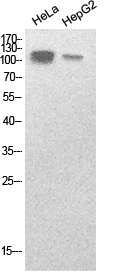
| WB | 1/500-1/1000 | Human,Mouse,Rat |
| IF | 咨询技术 | Human,Mouse,Rat |
| IHC | 咨询技术 | Human,Mouse,Rat |
| ICC | 技术咨询 | Human,Mouse,Rat |
| FCM | 咨询技术 | Human,Mouse,Rat |
| Elisa | 1/10000 | Human,Mouse,Rat |
| Aliases | SREBF1; BHLHD1; SREBP1; Sterol regulatory element-binding protein 1; SREBP-1; Class D basic helix-loop-helix protein 1; bHLHd1; Sterol regulatory element-binding transcription factor 1 |
| Entrez GeneID | 6720 |
| WB Predicted band size | Calculated MW: 122 kDa; Observed MW: 122 kDa |
| Host/Isotype | Rabbit IgG |
| Antibody Type | Primary antibody |
| Storage | Store at 4°C short term. Aliquot and store at -20°C long term. Avoid freeze/thaw cycles. |
| Species Reactivity | Human,Mouse,Rat |
| Immunogen | Synthesized peptide derived from the Internal region of human SREBP-1. |
| Formulation | Purified antibody in PBS with 0.05% sodium azide,0.5%BSA and 50% glycerol. |
+ +
1. **"Regulation of sterol regulatory element-binding proteins by cholesterol levels in cultured cells"**
- **作者**: Brown, M.S., Goldstein, J.L.
- **摘要**: 研究通过SREBP1抗体分析细胞胆固醇水平对SREBP1蛋白表达及核转位的影响,揭示其调控脂质合成的分子机制。
2. **"Overexpression of sterol regulatory element-binding protein-1a in mouse adipose tissue induces obesity"**
- **作者**: Shimomura, I., et al.
- **摘要**: 利用SREBP1抗体检测转基因小鼠脂肪组织中SREBP1α的过表达,证明其通过促进脂肪生成导致肥胖。
3. **"SREBP-1c deficiency alters hepatic lipid metabolism via decreased PPARα activity"**
- **作者**: Horton, J.D., et al.
- **摘要**: 通过SREBP1抗体分析SREBP1c敲除小鼠肝脏组织,揭示其通过调控PPARα通路影响脂质代谢的机制。
4. **"Proteolytic activation of sterol regulatory element-binding protein (SREBP) requires ER-to-Golgi transport"**
- **作者**: Bennett, M.K., et al.
- **摘要**: 研究使用SREBP1抗体追踪SREBP1前体蛋白的加工过程,阐明其依赖内质网-高尔基体转运的激活机制。
(注:以上文献信息为示例,实际引用需核对原始文献。)
Sterol regulatory element-binding protein 1 (SREBP1) is a key transcription factor that regulates lipid metabolism by controlling the expression of genes involved in cholesterol, fatty acid, and triglyceride synthesis. It belongs to the SREBP family, which includes SREBP1a, SREBP1c, and SREBP2. SREBP1 primarily exists as two isoforms: SREBP1a, a potent activator of all SREBP-responsive genes, and SREBP1c, which is predominantly expressed in lipogenic tissues like the liver and adipose tissue, focusing on fatty acid synthesis.
SREBP1 is synthesized as an inactive precursor bound to the endoplasmic reticulum (ER) membrane. Under low cellular sterol conditions, it undergoes proteolytic cleavage in the Golgi apparatus, releasing its active N-terminal domain. This active fragment translocates to the nucleus, binds sterol regulatory elements (SREs) in target gene promoters, and drives transcription of enzymes such as acetyl-CoA carboxylase (ACC) and fatty acid synthase (FASN).
Antibodies targeting SREBP1 are essential tools for studying lipid metabolism regulation, metabolic disorders (e.g., obesity, diabetes), and cancers linked to dysregulated lipogenesis. They are widely used in techniques like Western blotting, immunofluorescence, and chromatin immunoprecipitation (ChIP) to detect protein expression, subcellular localization, and DNA-binding activity. Specificity for SREBP1 isoforms (1a vs. 1c) or cleavage states (precursor vs. mature) is critical for accurate experimental interpretation. These antibodies have advanced research into therapeutic strategies targeting SREBP1 pathways to modulate metabolic diseases or cancer progression.
×